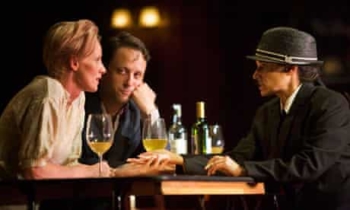
The Select
(The Sun Also Rises) • Press
- DC Theater Scene March 1, 2017
- Shakespearences March 1, 2017
- DC Metro Theater Arts March 2, 2017
- The Georgetown Dish March 1, 2017
- DC Metro Theater Arts March 1, 2017
- Women Around Town March 1, 2017
- The Washington Post February 28, 2017
- Timeout New York September 11, 2012
- New York Times September 11, 2011
- The Irish Times September 30, 2012
- Timeout Boston March 17, 2011
- The Independent August 20, 2010
- The Scotsman August 26, 2010
- What's On Stage August 16, 2010
- British Theatre Guide August 2010
- Sarasota Herald-Tribune October 8, 2009
The Sun Also Rises
by Lyn Gardner
Jonathan Mills has opened Edinburgh’s eyes to the pleasures of the New York avant garde with companies such as Mabou Mines, the Wooster Group and Elevator Repair Service.
It’s the latter who are in town performing theatrical open-heart surgery on Ernest Hemingway’s first major success. They do it with surgical expertise and a droll, playful humour, even if, at close to four hours, it sometimes feels as if the sun hasn’t just risen but might even set, too. It is too long (particularly in the less absorbing first half), and yet not long enough, as if we need to feel as if we are not just watching but enduring the listless desperation of a lost generation.
This is not a stage adaptation of Hemingway’s novel — about a group of boozed-up writers and American and Brit ex-pats in Paris who take jaunts to Spain in the 1920s — it is a collision. All around is the sound of breaking glass and breaking hearts, as the war-wounded Jake Barnes (Mike Iveson) tells of his unconsummated love affair with Brett Ashley (Lucy Taylor), a femme fatale who proves fatal to male friendships as the group party towards oblivion during the Pamplona fiesta. The bullfight is brilliantly staged using tables.
One of the most astonishing things about this evening besides its endless array of bottles and glasses of alcohol — like bewitching vivid green or pink jewels — is the way it uses sound and light. Sound is like an additional character in the drama, whether it’s the scrape of blade against cheek when shaving, the pop of a champagne cork or the sound of a punch being thrown that points up the cartoon absurdity of jealous men fighting. The lighting reveals shadows in which human passions and bottles loom large, the diamond dazzle of light catching a glass like a temptation. If it were not for the fact that these people are so tedious in their drunken self-absorption, you might be tempted to reach for the bottle yourself.
The show is at it most persuasive when it is at its most heightened, whether that is in the way it draws attention to its own narrative style, or how it plays with the tension between emotion and action, the felt and the expressed, the exposed and the concealed, the watched and watcher. It’s most apparent in the jaunty dances that offer a direct opposition to the desperation felt. It may not quite deliver full satisfaction as a portrait of dissatisfaction, but when they take the bull by the horns and give it a good shake, this company really know how to bellow.
View the original article on The Guardian website here.